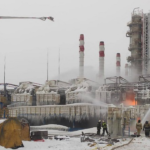Ukraine and Russia have exchanged 70 prisoners in the biggest prisoner swap since the outbreak of the war in Eastern Ukraine. Among the Ukrainians were 24 sailors who had been captured by Russia during the Kerch Strait crisis, two activists, a journalist, and filmmaker Oleg Sentsov. Oleg Sentsov had been sentenced to more than 20 years in prison on bogus terrorism charges for speaking against the Russian annexation of Crimea. The Ukrainian prisoners were greeted by Ukrainian President Volodymyr Zelenskiy and their families at Kyiv Boryspil airport.
While Moscow has not confirmed the names of the Russian prisoners, one of them is known to be Volodymyr Tsemakh, a separatist commander linked to the downing of Malaysian Airlines Flight MH17 in 2014. The Netherlands have expressed disappointment over Tsemakh’s release. The Russian prisoners arrived at Moscow’s Vnukovo airport without festivities and were immediately bussed to a medical facility.
This major prisoner exchange is viewed as a step towards a peaceful conflict resolution, as Ukraine and Russia were able to find an agreement. The Normandy Four framework (France, Germany, Ukraine and Russia) is planning a new meeting to discuss the conflict in Donbas and Luhansk.
COMMENTARY: IS THE EXCHANGE A GAME CHANGER?
In spite of numerous failed ceasefire negotiations and the two unimplemented Minsk agreements, Ukraine’s troubled regions remain highly volatile. The Russian Armed Forces continue to deploy troops and to enhance the capabilities of their local proxy forces. The Normandy Four is a toothless tiger as France and Germany have time and again demonstrated their soft stance and lack of leverage towards Russia.
If anything has helped Ukraine’s position, it was the lethal aid from the United States, which included the tank-busting Javelin missile. The influx of armor-piercing missiles for Ukraine’s infantry has raised the costs of a renewed Separatist motorized or armored assault. The conflict in Eastern Ukraine will likely remain frozen for the foreseeable future.
Photo @ Gleb Garanich/Reuters
- Russia Bombs Maternity Ward & Children’s Hospital in Mariupol As Part of Siege - 10 March 2022
- T-Intell’s OSINT Training Marks One Year Anniversary - 18 November 2021
- IS-K Never Left the Battlefield - 27 August 2021









